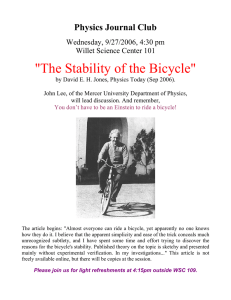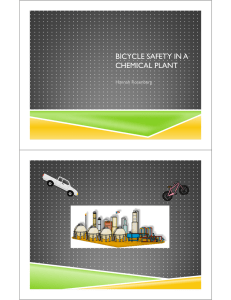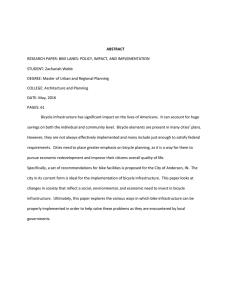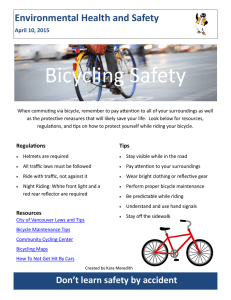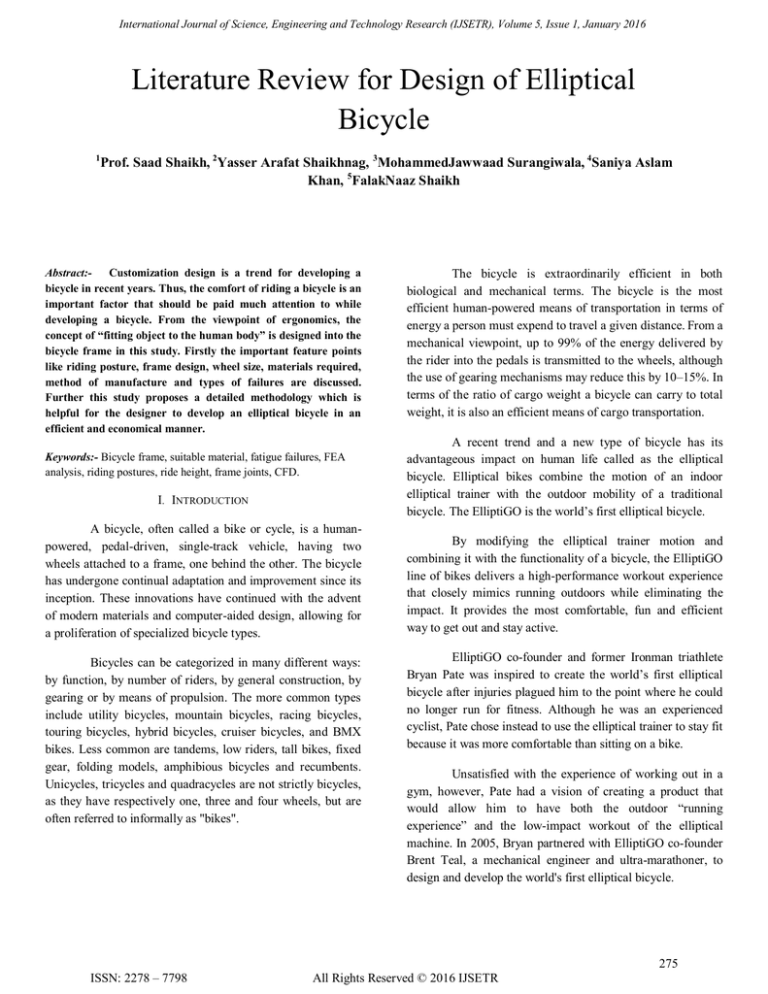
International Journal of Science, Engineering and Technology Research (IJSETR), Volume 5, Issue 1, January 2016
Literature Review for Design of Elliptical
Bicycle
1
Prof. Saad Shaikh, 2Yasser Arafat Shaikhnag, 3MohammedJawwaad Surangiwala, 4Saniya Aslam
Khan, 5FalakNaaz Shaikh
Abstract:Customization design is a trend for developing a
bicycle in recent years. Thus, the comfort of riding a bicycle is an
important factor that should be paid much attention to while
developing a bicycle. From the viewpoint of ergonomics, the
concept of “fitting object to the human body” is designed into the
bicycle frame in this study. Firstly the important feature points
like riding posture, frame design, wheel size, materials required,
method of manufacture and types of failures are discussed.
Further this study proposes a detailed methodology which is
helpful for the designer to develop an elliptical bicycle in an
efficient and economical manner.
Keywords:- Bicycle frame, suitable material, fatigue failures, FEA
analysis, riding postures, ride height, frame joints, CFD.
I. INTRODUCTION
A bicycle, often called a bike or cycle, is a humanpowered, pedal-driven, single-track vehicle, having two
wheels attached to a frame, one behind the other. The bicycle
has undergone continual adaptation and improvement since its
inception. These innovations have continued with the advent
of modern materials and computer-aided design, allowing for
a proliferation of specialized bicycle types.
Bicycles can be categorized in many different ways:
by function, by number of riders, by general construction, by
gearing or by means of propulsion. The more common types
include utility bicycles, mountain bicycles, racing bicycles,
touring bicycles, hybrid bicycles, cruiser bicycles, and BMX
bikes. Less common are tandems, low riders, tall bikes, fixed
gear, folding models, amphibious bicycles and recumbents.
Unicycles, tricycles and quadracycles are not strictly bicycles,
as they have respectively one, three and four wheels, but are
often referred to informally as "bikes".
The bicycle is extraordinarily efficient in both
biological and mechanical terms. The bicycle is the most
efficient human-powered means of transportation in terms of
energy a person must expend to travel a given distance. From a
mechanical viewpoint, up to 99% of the energy delivered by
the rider into the pedals is transmitted to the wheels, although
the use of gearing mechanisms may reduce this by 10–15%. In
terms of the ratio of cargo weight a bicycle can carry to total
weight, it is also an efficient means of cargo transportation.
A recent trend and a new type of bicycle has its
advantageous impact on human life called as the elliptical
bicycle. Elliptical bikes combine the motion of an indoor
elliptical trainer with the outdoor mobility of a traditional
bicycle. The ElliptiGO is the world’s first elliptical bicycle.
By modifying the elliptical trainer motion and
combining it with the functionality of a bicycle, the ElliptiGO
line of bikes delivers a high-performance workout experience
that closely mimics running outdoors while eliminating the
impact. It provides the most comfortable, fun and efficient
way to get out and stay active.
ElliptiGO co-founder and former Ironman triathlete
Bryan Pate was inspired to create the world’s first elliptical
bicycle after injuries plagued him to the point where he could
no longer run for fitness. Although he was an experienced
cyclist, Pate chose instead to use the elliptical trainer to stay fit
because it was more comfortable than sitting on a bike.
Unsatisfied with the experience of working out in a
gym, however, Pate had a vision of creating a product that
would allow him to have both the outdoor ―running
experience‖ and the low-impact workout of the elliptical
machine. In 2005, Bryan partnered with ElliptiGO co-founder
Brent Teal, a mechanical engineer and ultra-marathoner, to
design and develop the world's first elliptical bicycle.
275
ISSN: 2278 – 7798
All Rights Reserved © 2016 IJSETR
International Journal of Science, Engineering and Technology Research (IJSETR), Volume 5, Issue 1, January 2016
II. LITERATURE REVIEW
A Bi-cycle frame should have low weight, high
lateral stiffness and moderate vertical stiffness. Because of
chain load, frame lateral deformation during pedalling is
bigger when the rider pushes on right pedal (a pro rider may
apply a force up to two times his weight). Most of the bicycles
built today utilize heat treated steel or aluminium or titanium
alloy tubing to minimize their weight. The tubes are then
welded together to create the desired fork or frame geometry.
[1]
In recent years, as manufacturers of racing bicycles
and bicycle components have turned to wind tunnel testing to
optimize component design3, the athletes themselves are now
able to purchase time in wind tunnels to refine and perfect
their riding positions. Comprehensive reviews by Burke4 and
Lukes cite many efforts which validate the conventional
wisdom that the main contributors to overall drag are the rider,
the frame including fork and aerobars, and the wheels.
Greenwell et.al.6 have concluded that the drag contribution
from the wheels is on the order of 10% to 15% of the total
drag, and that with improvements in wheel design, an overall
reduction in drag on the order of 2% to 3% is possible. [2]
Since their invention in 1817, bicycles have proven to
be a healthy and environmentally friendly mode of
transportation for both enthusiasts and commuters alike.
Although the bicycle has remained ubiquitous over time, the
world has changed dramatically. Today, US roadways are
dominated by automobiles, aggressive, modes of human
transport. Unfortunately, bikers are considered second-class
citizens as they attempt to share roadways with motorists. In
fact, this has been the situation for most of the lifetime of the
bicycle. [3]
A schematic of bicycle frame size obtained from the
riding experiment is shown in Fig. 1 Generally, the three key
feature points: handlebars, the saddle and the central crank,
were used as the kernel to mark the frame size.
A represents the vertical distance from the saddle to the
ground; B the vertical distance from the crank center to the
ground; C the vertical distance from the handlebars to the
ground; D the horizontal distance from the handlebars to the
saddle; and, E the horizontal distance from the crank center to
the saddle. By this marking method, different frame sizes for
different human dimensions could be clearly illustrated. [4]
Fig. 1:- Positions of feature points and their feature angles
formed when riding. [4]
Spoked bicycle wheels are efficient, highly evolved,
structural systems. A useful analogy for a bicycle wheel
supporting vertical loads is that of a circular beam on a
prestressed elastic foundation, fixed at the center and loaded
radially at the circumference. To apply this analogy, the
system of interlacing spokes can be modeled as a disk of
uniform stiffness per length of circumference. Spokes of
varying lengths may be laced into wheels of fixed dimensions,
by modifying the interlacing geometry of the spokes. [5]
Fig. 2:- Tangential stiffness for various bicycle wheel designs.
[5]
276
ISSN: 2278 – 7798
All Rights Reserved © 2016 IJSETR
International Journal of Science, Engineering and Technology Research (IJSETR), Volume 5, Issue 1, January 2016
It is possible to build a bicycle frame with very little
equipment. I have done it myself. It took me a lot longer than
it would if I had a few more items of quality equipment, and it
was awkward and took lots of concentration. Deciding on the
right amount of equipment is up to the individual frame
builder. It will depend on how he/she wishes to make frames,
the space available to house the equipment and the finances at
their disposal. As can be seen in my case studies, frame
builders can be successful using several different
―philosophies‖ with regard to equipment. Take Richard Sachs
for example: he is one of the most well-known and successful
frame builders in the world, yet he doesn’t have a milling
machine or a lathe. In fact, his workshop is noticeably devoid
of equipment apart from a frame jig, a couple of benches, a
vice and some hand tools. [6]
Toughness- Toughness is the ability of a metal to absorb
energy and deform before fracturing (breaking). A tough metal
is more ductile (pliable) and deforms rather than breaks. [7]
Fatigue is a prominent failure mechanism for
mountain bike frames, and can lead to serious accidents, costly
recalls, and poor product image for bicycle frame
manufacturers. The team collaborated with a local bike
company, in the process of developing a new 6061-T6
aluminum mountain bike, to investigate the fatigue behavior
of the new frame and optimize the material/heat treatment and
frame design. [8]
What are the best materials to use in bicycle
frames—steel? aluminum? carbon fiber? magnesium?
titanium? The answer lies in the physical properties of these
materials—their characteristics and how they behave under
certain conditions. The designer chooses the material that best
suits the intended use of the bike (road or off road), and the
expected cost (titanium and carbon fiber are especially
expensive). Listed below are some of the properties bike
designers look at when they build a bicycle.
Density- Density is how much a material weighs for a given
volume.
Stiffness- The measurement for stiffness is called the modulus
of elasticity; it is the degree to which a material that undergoes
stress can deform, and then recover and return to its original
shape after the stress ceases
Elongation- Elongation is a measure of how far a material
will stretch before it breaks. It is very sensitive to the type of
alloy used and how the metal is processed.
Tensile Strength- Tensile strength is a measure of the greatest
longitudinal stress a substance can bear without tearing apart;
it is expressed as a ratio of maximum load to crosssectional
area.
Fatigue Strength- Fatigue strength is a measure of the stress
at which a material fails after a number of cycles. Steel and
titanium alloys have a specific fatigue strength below which a
load (force) may be applied an infinite number of times
without causing the metal to bend or break.
Fig. 3:- Tubing diagram of the donated bicycle frames. [8]
As far back as 1986, Peterson and Londry (1986)
used FEA to fine-tube the design of the Trek 2000 aluminium
frame using two other existing designs (one steel, one
aluminium) as performance benchmarks for mass, strength
and stiffness characteristics. Their model used beam elements
to represent the tubular frame structure (excluding forks) with
restraints at the rear axle and head tube, and loads applied in a
range of load cases at the seat tube, head tube, brake bridge,
and bottom bracket (BB). While this study did not include an
analysis of varied geometry, the analysis of varied load cases
provided a rich insight into various generic performance
characteristics, for example that energy losses in the vertical
direction could be increased with little negative effect on hill
climbing performance (i.e. an out of saddle load case) and that
the down tube was always the greatest strain energy absorber,
storing between 38-49% of the total (followed by the seat
tube, storing between 19-25%). [9]
Developments have recently been made in analysis of
bicycle self stability. Applicability of benchmarked linearized
dynamics equations to a variation of modern bicycle designs is
277
ISSN: 2278 – 7798
All Rights Reserved © 2016 IJSETR
International Journal of Science, Engineering and Technology Research (IJSETR), Volume 5, Issue 1, January 2016
investigated. Results gained through experimentation on an
instrumented bicycle with variable geometry are compared to
predicted results. Precise three dimensional modeling is used
to calculate bicycle mass properties, for use in dynamics
equations. Strong correlations between experimental and
predicted results are found over large variations in bicycle
geometry. Bicycles have been the subject of much research
throughout their development. This thesis studies self stability
of bicycles, which until recently had not been completely
captured and verified mathematically. [10]
In this work CFD was used to explore the complex
and unsteady nature of air flow around several commercially
available front bicycle wheel configurations. Extending our
previous work, this study examined more realistic front wheel
geometry, adding the front fork, top tube, head tube, down
tube, caliper and brake pads to the modeling domain: Three
wheels, namely the Zipp 404, Zipp1080 and HED H3
TriSpoke were considered. In addition, two commercially
available front fork designs, the Reynolds Carbon fork and the
Blackwell Bandit slotted fork, were also studied. [13]
Most mechanics textbooks or treaties on bicycles
either ignore the matter of their stability or treat it fairly
trivial. The bicycle is assumed to be balanced by the action of
its rider who, if he feels the vehicle falling, steers into the
direction of the fall and so traverses a curved trajectory of
such a radius as to generate enough centrifugal force to correct
the fall. The next level of sophistication in current bicycle
stability theory invokes the gyroscopic action of the front
wheel. If this bike tilts, the front wheel processes about the
steering axis and steers it in a curve that as, before, counteracts
the tilt. [11]
To obtain a sense of the relative performance merits
for the design configurations studied here, the overall power
requirements were calculated for each combination of front
wheel and fork; wheel only configurations were not included
here. In general, it was observed for all cases that the power
requirement needed to increase the speed from 20mph to
30mph went up by a factor slightly greater than three. This
result is consistent with the convention that the increase in
power goes up with the cube of the increase in speed. [14]
An experimental analysis of the frame design for a
hybrid bicycle was presented. The analysis was conducted to
obtain an understanding of the dynamics load distribution
which may be encountered during competitive riding.
Experimental measurements were also necessary for a
verification of numerical analysis. Dynamic strains resulting
from typical riding events indicated that the design scaling
from static to dynamic events required a scaling factor of at
least 20. In addition, the load history resulting from dynamic
activities provided the appropriate information necessary for a
preliminary fatigue design analysis. [12]
Several critical issues such as the wheel rim depth
and cross-sectional profile, wheel diameter (650c or 700c),
and development of an integrated front fork/frame/caliper
assembly, optimized to work with a specific wheel, still
remain open. We believe that CFD is now in a position to fully
explore wind tunnel discoveries, and advance the
understanding of the critical design changes which ultimately
lead to the performance improvements sought after by
competitive and amateur cyclists and triathletes. [15]
In this paper, we present an approach that solves the
problem by offloading the low-level cognitive requirements
from a biker to her bicycle. To support this approach, we
enhance a standard bicycle with sensing and computational
capabilities to create a Cyber-Physical bicycle system. The
core goal of this system is to provide accurate and timely
detection of rear-approaching vehicles to alert the biker of the
pending encounter, through the cross-cutting application of
mobile sensing, computer vision, and audio processing
techniques. [16]
The central goal of this work is to reduce the
cognitive overhead of a biker to allow her to focus attention on
bicycle handling and the roadway ahead. Evaluating this is a
challenging problem as it requires thorough coverage of
different biker skill levels, riding styles, roadway and route
characteristics, environmental conditions, and user interface
issues. As such, we acknowledge the importance and need for
Fig. 4:- Fatigue limit of aluminum vs. steel [12]
278
ISSN: 2278 – 7798
All Rights Reserved © 2016 IJSETR
International Journal of Science, Engineering and Technology Research (IJSETR), Volume 5, Issue 1, January 2016
a full user study and plan to conduct one in the future as a
separate, but related piece of research. [17]
and increased down tube thickness near the bottom bracket.
[20]
This study defined five joint angles in the
measurement of riding postures. Since each feature joint angle
was constantly changing during the process of measurement,
this study used only the feature angles when the tests stopped
at the lowest stepping point in riding as the required measured
results. Meanwhile, the changing range of each testers' body
angle on different bicycle types was recorded. [18]
III. METHODOLOGY
1. Material Selection:The material required for developing an elliptical bicycle must
be selected very carefully as the stresses and fatigue forces
involved are different than the conventional bicycle. As per
the material survey the best suited material is the alloy steel
(SS). The mentioned material was chosen as the material for
bicycle frame due to its low density and compatible yield
strength. This material was chosen for designing frame and
comparing its results with different materials as mild steel,
EN8 etc.
Optional Material:1. Al-6061-magnesiam and Silicon Major Alloying Elementdensity 2.70g/Cm^3.
2. Al-7005-Zinc-density-2.78g/cm^3- depending on the
temper, may be slightly stronger.
2. Designing of the Model:The frame required to be developed for elliptical bicycle can
be designed by standard designing procedures and if the load
carrying capacity of the frame is known.
3. Drafting a CAD Model:-
Fig. 5:- Bicycle frame size captured by detection system. [18]
The spoke pattern affects the over-all radial stiffness
of the wheel more than it affects the spoke strains. From a
theoretical analysis, a numerical analysis, static experimental
analysis, and in-service measurements, the spoke strains
appear to be insensitive to the pattern of the spoke lacing.
From a numerical analysis, the spoking pattern has the greatest
impact on the spoke strains when the wheel is subjected to
large lateral loads, such as during cornering. In this case,
wheels with longer spokes have lower strains than do wheels
with shorter spokes. [19]
An investigation was conducted with the optimal
material / heat treatment, and geometry design. The optimal
6013-T6 alloy was set for the frame material. The geometry
was optimized with the extended weld between the top and
down tube, increased radius of curvature for the down tube,
Required CAD can be developed using 3-D modeling
softwares. The cad geometry must have basic requirement for
Head tube, top tube, bottom tube, chain stays, bottom bracket
shell and the two triangles commonly says diamond frame.
This is the model of the bicycle frame. A bicycle frame is the
main component of a bicycle, onto which wheels and other
components are fitted. The modern and most common frame
design for an upright bicycle is based on the safety bicycle,
and consists of two triangles, a main triangle and a paired rear
triangle. Frames are required to be strong, stiff and light,
which they do by combining different materials and shapes.
4. Meshing:For better quality mesh combination of first and second order
tetra elements are to used. Surface meshing using triangular
elements is to be performed to achieve better control on the
meshing. Further this mesh will be converted into a tetra
mesh. Selective tetra elements will be converted into second
279
ISSN: 2278 – 7798
All Rights Reserved © 2016 IJSETR
International Journal of Science, Engineering and Technology Research (IJSETR), Volume 5, Issue 1, January 2016
order and selective regions will be finely meshed using first
order elements controlling the number of nodes formed.
5. Frame Analysis:Several properties of a material help decide whether it is
appropriate in the construction of a bicycle frame:
1. Density (or specific gravity) is a measure of how light or
heavy the material per unit volume.
2. Stiffness (or elastic modulus) can in theory affect the ride
comfort and power transmission efficiency. In practice,
because even a very flexible frame is much more stiff than the
tires and saddle, ride comfort is in the end more a factor of
saddle choice, frame geometry, tire choice, and bicycle fit.
Lateral stiffness is far more difficult to achieve because of the
narrow profile of a frame, and too much flexibility can affect
power transmission, primarily through tire scrub on the road
due to rear triangle distortion, brakes rubbing on the rims and
the chain rubbing on gear mechanisms. In extreme cases gears
can change themselves when the rider applies high torque out
of the saddle.
6. Fabrication of the Model:After the analysis of the model, on analysis softwares for
different loads and environmental conditions, the frame can be
fabricated followed by the selection of suitable material after
market survey. Fabrication techniques include welding,
bending and assembly of various parts required.
7. Testing of the Fabricated Model:Followed by the fabrication of the actual model, it should be
tested for different road and environmental conditions to
identify any defects or flaws in the design or fabrication
processes.
8. Troubleshooting:If any defects or flaws are found in the fabricated model, the
defects or flaws will be corrected/rectified by taking suitable
steps.
be used to calculate the frame sizes of common bicycle types
by numeric operations. In the above literature review the size
and type of wheel to be selected for a particular bicycle
application is instructed. The various fatigue failures,
materials required and analysis included in fabrication of a
bicycle is cited in detail.
REFERENCES
[1] Sagar Pardeshi, Pankaj Desle ―Design and Development of Effective Low
Weight Racing Bicycle Frame‖, International Journal of Innovative Research
in Science, Engineering and Technology (IJIRSET). December 2014.
[2] Matthew N. Godo, David Corson, Steve M. Legensky, ―A Practical
Analysis of Unsteady Flow Around a Bicycle Wheel, Fork and Partial Frame
Using CFD‖ American Institute of Aeronautics and Astronautics.
[3] Stephen Smaldone, Chetan Tonde, Vancheswaran K. Ananthanarayanan,
Ahmed Elgammal, and Liviu Iftode, ―Improving Bicycle Safety through
Automated Real-Time Vehicle Detection‖ Department of Computer Science
Rutgers University 110 Frelinghuysen Rd, Piscataway, NJ 08854, August
2010.
[4] Shih-Wen Hsiao, Rong-Qi Chen, Wan-Lee Leng, ―Applying ridingposture optimization on bicycle frame design‖ Department of Industrial
Design, National Cheng Kung University, Tainan 70101, Taiwan, ROC, April
2015.
[5] Henri P. Gavin, ―Bicycle Wheel Spoke Patterns and Spoke Fatigue‖,
ASCE Journal of Engineering Mechanics, vol 122, no. 8, (August 1996) pp.
736–742. August 1996.
[6] Matt Wilkinson, ―The Winston Churchill Memorial Trust Travelling
Fellowship 2011‖, Bicycle Frame Building in the USA. May 2011.
[7] Nicol, Scot, ―Metallurgy for cyclists
http://www.63xc.com/scotn/metal.htm, March 1999.
I:
The
basics‖,
[8] Forrest Dwyer, Adrian Shaw, Richard Tombarelli, ― Material and Design
Optimization for an Aluminum Bike Frame‖, Worcester Polytechnic Institute.
April 2012.
[9] Derek Covilla, Steven Begga, Eddy Eltona, Mark Milnea, Richard
Morrisa, Tim Katza, ―Parametric finite element analysis of bicycle frame
geometries‖, School of Computing, Engineering and Mathematics, University
of Brighton, Lewes Rd, Brighton, BN2 4GJ, UK, April 2014.
[10] David Stevens, ―The Stability and Handling Characteristics of Bicycles‖,
The University of New South Wales, School of Mechanical and
Manufacturing Engineering, June 2009.
[11] David E.H. Jones, ―The Stability of the bicycle‖, Feature Article. From
the Archives, September 2006.
IV. CONCLUSION
The above study/ literature review proposed a method for
measuring the comfortable postures of bicycle riding and
applied the results to bicycle frame design. It also defines the
means to effectively measure the best frame size for riders of
different height ranges on different bicycle types. It could also
[12] D. Arola, P.G. Reinhall, M.G. Jenkins , S.C. Iverson, ―An Experimental
Analysis Of A Hybrid Bicycle Frame‖, Journal of Experimental Techniques.
May/ June 1999.
[13] Godo, M.N, Corson, D. and Legensky, S.M., 2009, ―An Aerodynamic
Study of Bicycle Wheel Performance using CFD‖, 47th AIAA Aerospace
280
ISSN: 2278 – 7798
All Rights Reserved © 2016 IJSETR
International Journal of Science, Engineering and Technology Research (IJSETR), Volume 5, Issue 1, January 2016
Sciences Annual Meeting, Orlando, FL, USA, 5-8 January, AIAA Paper No.
2009-0322.
[14] Garcia-Lopez, J., Rodriguez-Marroyo, J.A., Juneau, C.-E., Peleteiro, J.,
Martinez, A.C. and Villa, J.G., 2008, ―Reference values and improvements of
aerodynamic drag in professional cyclists‖, J. Sports Sci., 26(3), pp. 277-286.
[15] FieldView, CFD Postprocessing Software Package, Version 12.3,
Intelligent Light, Rutherford, NJ, 2009.
[16] S. B. Eisenman, E. Miluzzo, N. D. Lane, R. A. Peterson, G.-S. Ahn, and
A. T. Campbell. The bikenet mobile sensing system for cyclist experience
mapping. In SenSys '07: Proceedings of the 5th international conference on
Embedded networked sensor systems, 2007.
[17] M. Enzweiler and D. Gavrila. Monocular pedestrian detection: Survey
and experiments. 31(12):2179-2195, December 2009.
[18] Bressel, E., Bliss, S., Cronin, J., 2009. A field-based approach for
examining bicycle seat design effects on seat pressure and perceived stability.
Appl. Ergon. 40, 472e476.
[19] Pippard, A.J.S., and Francis, W.E. (1931) ―The stresses in a radiallyspoked wire wheel under loads applied to the rim.‖ Philosophical Magazine,
7(11), 233-285.
[20] ASTM Standard F2868-10, "Standard Specification for Condition 2
Bicycle Frames," ASTM International, West Conshohocken, PA,
www.astm.org.
1
Prof. Saad Shaikh , Faculty of Mechanical Engineering, Anjuman-IIslam’s Kalsekar Technical Campus, School of Engineering and Technology,
New Panvel, University of Mumbai, Maharashtra (India). Email ID:saad.shaikh7@gmail.com
2
Yasser Arafat Shaikhnag, B.E.Mechanical.(Student), Anjuman-IIslam’s Kalsekar Technical Campus, School of Engineering and Technology,
New Panvel, University of Mumbai, Maharashtra (India). E-mail ID:yass4uever@yahoo.com
3
MohammedJawwaad
Surangiwala,
B.E.Mechanical.(Student),
Anjuman-I-Islam’s Kalsekar Technical Campus, School of Engineering and
Technology, New Panvel, University of Mumbai, Maharashtra (India). Email
ID:-mohammed.jawwaad@gmail.com
4
Saniya Aslam Khan, B.E.Mechanical.(Student), Anjuman-I-Islam’s
Kalsekar Technical Campus, School of Engineering and Technology, New
Panvel, University of Mumbai, Maharashtra (India). Email ID:khanksaniya@yahoo.com
5
FalakNaaz Shaikh B.E.Mechanical.(Student), Anjuman-I-Islam’s
Kalsekar Technical Campus, School of Engineering and Technology, New
Panvel, University of Mumbai, Maharashtra (India). Email ID:falaknazsk@gmail.com
281
ISSN: 2278 – 7798
All Rights Reserved © 2016 IJSETR

